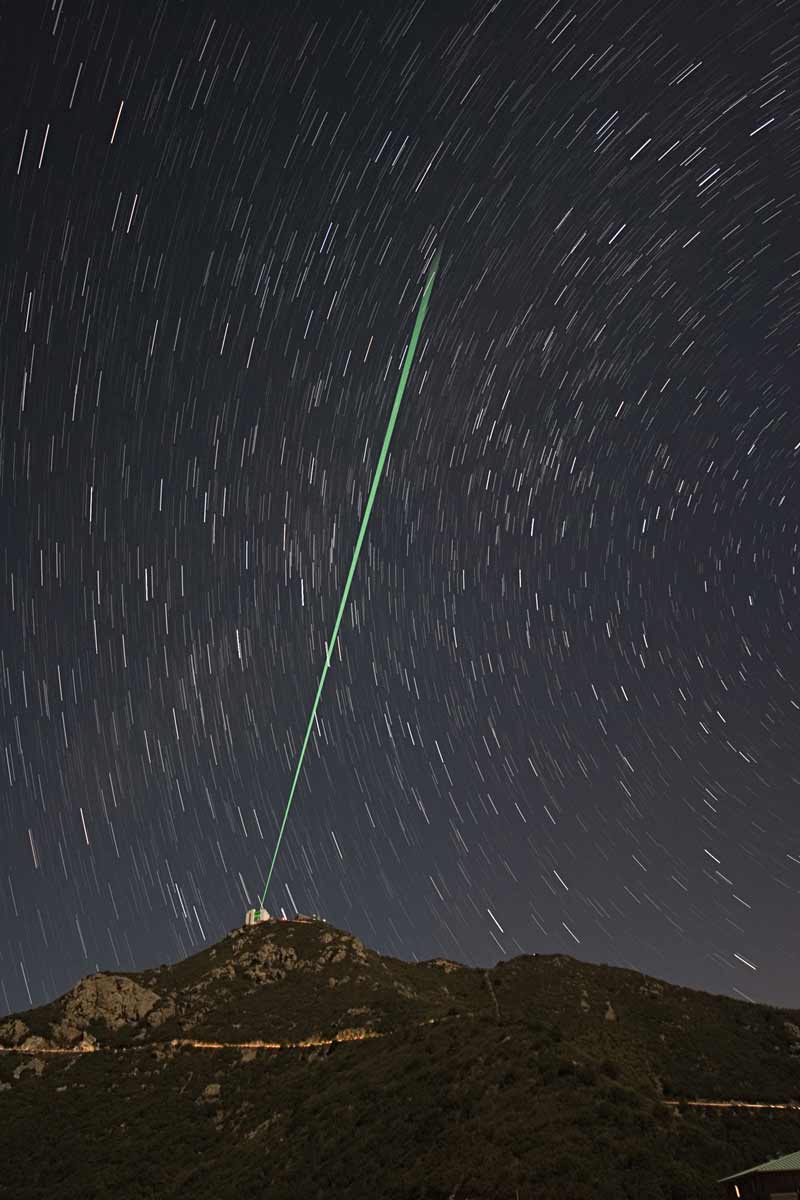Telescope's New Laser Vision Makes the Heavens Less Blurry

Scientists have successfully tested a new type of laser-correctedvision for telescopes that takes the widest starry-sky views ever seen from theground while eliminating blur caused by the atmosphere.
Now astronomers can see entire single star clusters or manydistant galaxies within the same field of view. That allows for more efficientuse of expensive telescopes and observing time to tackle challenges such asexamining thousands of early, distant galaxies. [Photo of the telescope laserin action.]
"You need to look at large patches of sky within oneshot, and you need to do it at high resolution," said study leader MichaelHart, an astronomer at the University of Arizona in Tucson.
Sharp wide views of space
The method developed by Hart's group cancels out atmosphericturbulence across a telescope view about one-fifteenth the diameter of a fullmoon. Its success will likely spread to the new class of 98-foot (30-meter)telescope giants such as the GiantMagellan Telescope planned for development in Chile.
Such work represents a major update of adaptive opticstechnology that has been around for decades. Ground telescopes use adaptiveoptics to adjust for the ever-changing blurry effect that comes from peering atspace through Earth's atmosphere, but can erase the blurriness only in a tinyview of the sky.
In adaptiveoptics, computers analyze the light from a natural or artificial guide staras a baseline to figure out the blurriness. Hundreds of actuators can then warpthe surface of the telescope mirrors thousands of times per second to cancelout the blurry effect.
Get the Space.com Newsletter
Breaking space news, the latest updates on rocket launches, skywatching events and more!
The new ground-layer adaptive optics system used five lasersmounted on the 21-foot (6.5-meter) MMT telescope at Mount Hopkins in Arizona. Pastsystems on other telescopes have used just one laser to create a singleartificial guide star.
Each laser points in a different direction so that they endup spread out in a pentagon pattern as they punch more than 15 miles (24 km)into the sky.
But the lasers are angled so that the light reflected backto the telescope aperture is just from the lowest layer of atmosphere, within one-third of a mile (500 meters) from the ground. Software can then pick out the common blurrysignal from that part of the atmosphere and adjust for it.
"If you correct the deleterious effects of the firstfew hundred meters of atmosphere, you go an awfully long way to fixingeverything," Hart told SPACE.com. "You also get a wide field of view,because the ground layer is close to telescope."
The study is detailed in the August 4 issue of the journalNature.
Wider view, lower resolution
That wide-view success came at the cost of resolution, sothat the images, while sharp, don't appear quite as sharp as those seen with traditionaladaptive optics.
But the tradeoff often becomes worthwhile. For instance,researchers want a wide enough field of view to see an entirestar cluster, as well as enough resolution to pick out the motions ofindividual stars.
Next up, Hart's team wants to correct for a much greaterlayer of atmospheric interference by creating a 3-D model of the turbulence.Telescopes would also need a stack of several adjustable mirrors to fix theblurriness in 3-D and get back some of the higher resolution ? an approachknown as multi-conjugate adaptive optics.
"What we're doing is shining laser beams through theatmosphere in all directions, so we can build an instantaneous snapshot of theatmosphere millisecond by millisecond," Hart explained.
The first-ever use of multiple lasers to create many guidestars also becomes crucial for the new giant telescopes under development,including the Giant Magellan Telescope, the Thirty-Meter Telescope and the EuropeanExtremely Large Telescope. Each instrument costs well within the range of$1 billion.
"If you're going to spend that amount of money, youbetter be darn sure that the telescope is able to produce the best science itcan, or it's not worth the money," Hart said.
- Earth's Most Important Telescopes
- The 10 Most Amazing Hubble Discoveries
- Bigger, Better Space Telescopes Following In Hubble's Footsteps
Join our Space Forums to keep talking space on the latest missions, night sky and more! And if you have a news tip, correction or comment, let us know at: community@space.com.
Jeremy Hsu is science writer based in New York City whose work has appeared in Scientific American, Discovery Magazine, Backchannel, Wired.com and IEEE Spectrum, among others. He joined the Space.com and Live Science teams in 2010 as a Senior Writer and is currently the Editor-in-Chief of Indicate Media. Jeremy studied history and sociology of science at the University of Pennsylvania, and earned a master's degree in journalism from the NYU Science, Health and Environmental Reporting Program. You can find Jeremy's latest project on Twitter.












